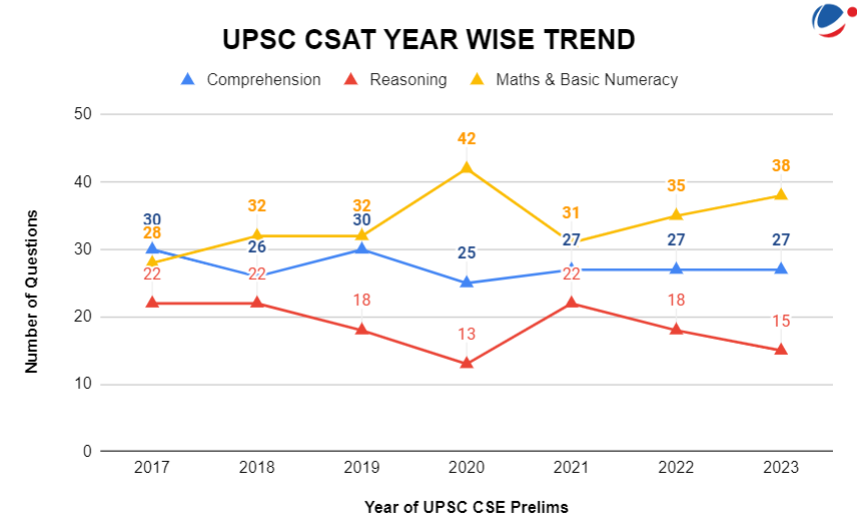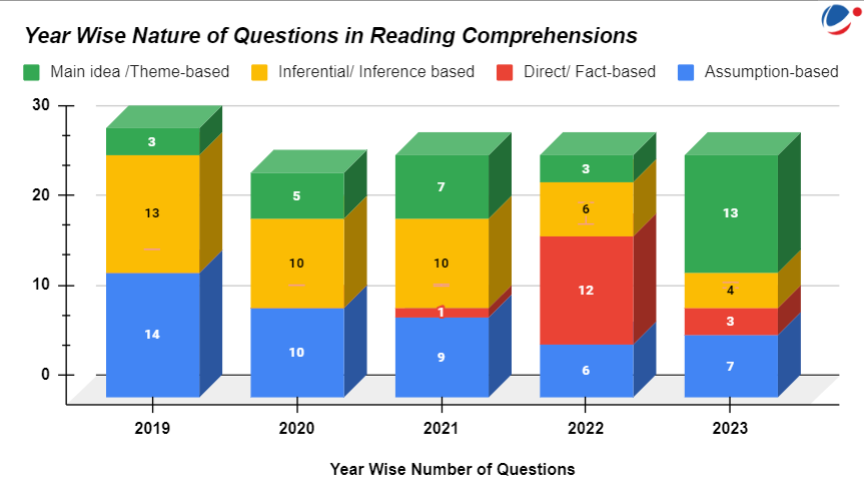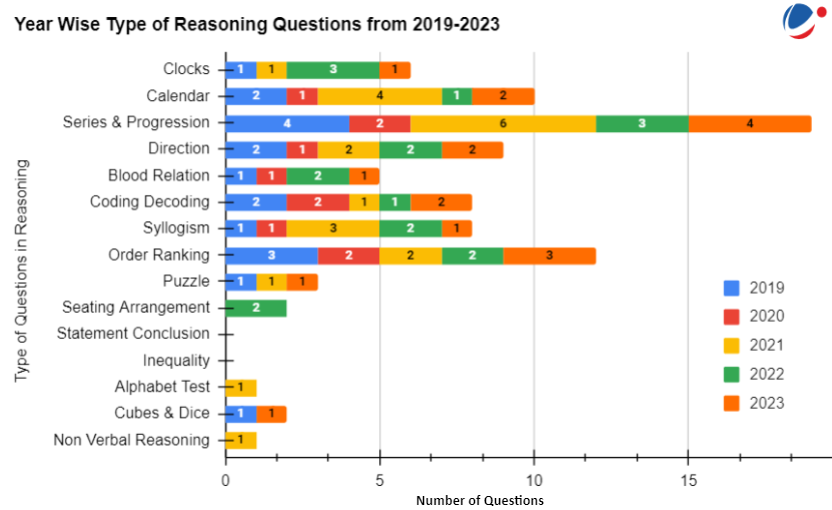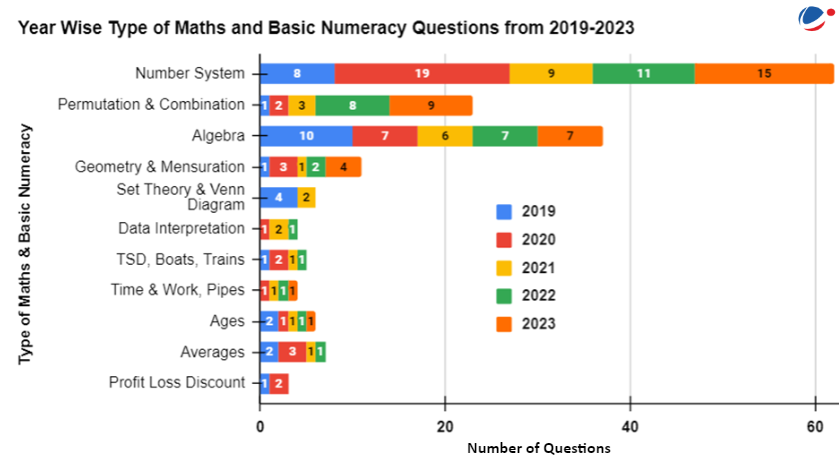Understanding of UPSC Prelims 2026 CSAT Syllabus is critical to sail through this paper. Lack of understanding of UPSC CSAT paper syllabus generally lead to practice of wrong type of questions. In this article we will try bring clarity to CSAT syllabus.
About UPSC Prelims 2026
The Civil Services Examination (CSE), conducted by the Union Public Service Commission (UPSC), is a comprehensive and multi-staged process. It is designed for the selection of candidates for two All India Services (IAS and IPS) and other Central Services. The exam is structured into three distinct phases, each with its own specific focus and evaluation criteria.
Three-phased Examination of UPSC
The preliminary exam (involving objective assessment) forms the first stage which screens out a vast number of candidates and selects a very few for the second stage, called the ‘mains’ exam.
In the mains exam, candidates have to write answers to subjective questions and only those who score above a certain threshold get a call for the third and the final stage, called the Personality Test round or the ‘interview’, but a candidate’s score in the ‘mains’ remains undisclosed.
It is only after the Personality Test round that the final result is announced based on the cumulative scores in the mains and the Personality Test round.
Evolution of UPSC Prelims CSAT
The UPSC Prelims underwent a significant overhaul in 2010-2011, transitioning from the pre-2011 format based on the Kothari Committee's 1979 recommendations. Originally, the Prelims consisted of a General Studies paper and a second paper from a choice of 23 optional subjects. Post-revision, both papers were standardized at 200 marks each, with the second paper evolving into what is now known as the Civil Services Aptitude Test (CSAT), aimed at evaluating candidates' analytical abilities.
However, the introduction of the CSAT led to controversies, especially among rural candidates who felt disadvantaged. Consequently, in 2014, the government announced that CSAT would be a qualifying paper with a 33% threshold, effective from 2015.
This change meant that CSAT scores would no longer contribute to the overall Prelims ranking, addressing the concerns raised and maintaining the essence of the test as an aptitude evaluation.
A Closer Look at UPSC CSE Prelims Examination
Presently, the preliminary stage of the Civil Services Examination, commonly known as the prelims, consists of two papers: General Studies Paper-I and General Studies Paper-II (commonly known as CSAT). In this stage, UPSC evaluates the aspirants' understanding, analytical skills, and time management through the General Studies (GS) syllabus, and their Civil Servant-like aptitude via mental ability, logical reasoning, and reading comprehension in CSAT.
Prelims Examination is meant to serve as a screening test only, the marks obtained in the Preliminary Examination by the candidates, who are declared qualified for admission to the Main Examination, are not counted for determining their final order of merit.
Presently, prelims consists of two papers carrying 400 marks in total, both of which are objective in nature, featuring multiple-choice questions. These question papers are set in both Hindi and English.
CSAT Exam Pattern & Marking Scheme
The UPSC Civil Services Aptitude Test (CSAT) is structured with a distinct exam pattern and marking scheme, which are essential for candidates to understand for effective preparation:
Exam Composition: The CSAT paper comprises 80 questions, with a total time allocation of 2 hours for completion. This structure requires candidates to manage their time efficiently to answer all questions within the given duration.
Scoring System: In the CSAT, each question carries 2.5 marks, leading to a total of 200 marks for the entire paper. This uniform marking across questions aids in strategic answering, focusing on accuracy to maximize scores.
Qualifying Criteria: Notably, the General Studies Paper-II (CSAT) is of a qualifying nature, requiring candidates to secure at least 33% to pass. Achieving this threshold is crucial as it enables candidates to progress to the next stage of the Civil Services Examination.
UPSC Prelims Syllabus for the General Studies Paper-II (CSAT)
The UPSC CSAT syllabus comprises the following broad categories:
- Comprehension
- Interpersonal skills including communication skills.
- Logical reasoning and analytical ability
- Decision-making and problem-solving
- General mental ability
- Basic numeracy (numbers and their relations, orders of magnitude, etc.) (Class X level), Data interpretation (charts, graphs, tables, data sufficiency, etc. – Class X level)
Decoding the Rules and Regulations
There is a penalty (negative marking) for wrong answers (1/3rd) marked by a candidate in Prelims. There are four alternatives for the answers to every question. If a candidate gives more than one answer, it is treated as a wrong answer even if one of the given answers happens to be correct and there will be the same penalty as above for that question. If a question is left blank, i.e. no answer is given by the candidate; there will be no penalty for that question.
Apart from that it is mandatory for the candidate to appear in both the Papers of Civil Services (Prelim) Examination for the purpose of evaluation. Therefore a candidate will be disqualified in case he/she does not appear in both the papers of Civil Services (Prelim) Examination.
UPSC CSAT Question Trends
Let's take a closer look at the question distribution and pattern over the years. The following graph outlines the trend from 2017 to 2023 in the distribution of questions across three key sections in the Civil Services Aptitude Test (CSAT): Comprehension, Reasoning, and Maths & Basic Numeracy. This overview helps in understanding the shifting focus and relative importance of these sections over the years.

Upon examining the graph, a few key trends become evident:
- Comprehension: This section has shown relatively minor fluctuations in the number of questions over the years, suggesting a stable focus on comprehension skills in the CSAT.
- Reasoning: A clear downward trend is observed in the number of Reasoning questions, indicating a decreasing emphasis on this section in the test.
- Maths & Basic Numeracy: Contrarily, there is an upward trend in the Maths & Basic Numeracy section, suggesting an increasing importance being placed on these skills in recent years.
Section-Wise Past Year Questions Trend & Observation:
Understanding the above prelims CSAT at analysis and trends in the question distribution is crucial for aspirants to tailor their preparation strategy accordingly. Let's now delve deeper into each section, examining the specific implications of these trends.
- Comprehension:

The Reading comprehension section of the CSAT has shown a consistent pattern over the years (2019-2023), demanding not just reading skills but also critical thinking. The overall difficulty level of this section can be considered moderate to challenging, depending on the candidate's familiarity with the question styles and reading proficiency.
Over the years, the pattern of passage's question largely revolves around logical inference, critical ideas, valid assumptions, logical corollaries among others. Typically, the length of passages presented in this section are short and rarely long passages included. Short passages, while seeming easier due to their length, often contain denser concepts.
The themes of passages in the CSAT comprehension section are diverse, including Religion, Science & Technology, Environment, International Relations, Law, and Philosophy, among others. Following is one of the examples from the previous year paper:
Passage Example: UPSC CSE 2023
In India, the segregation of municipal waste at source is rare. Recycling is mostly with the informal sector. More than three-fourths of the municipal budget goes into collection and transportation, which leaves very little for processing/resource recovery and disposal. Where does waste-to-energy fit into all this? Ideally it fits in the chain after segregation (between wet waste and rest), collection, recycling, and before getting to the landfill. Which technology is most appropriate in converting waste to energy depends on what is in the waste (that is biodegradable versus non-biodegradable component) and its calorific value. The biodegradable component of India's municipal solid waste is a little over 50 per cent, and biomethanation offers a major solution for processing this.
Based on the above passage, the following assumptions have been made:
1. Collection, processing and segregation of municipal waste should be with government agencies.
2. Resource recovery and recycling require technological inputs that can be best handled by private sector enterprises. Which of the assumptions given above is/are correct?
(a) 1 only
(b) 2 only
(c) Both 1 and 2
(d) Neither 1 nor 2
- Reasoning

The reasoning section in the CSAT paper plays a crucial role in evaluating a candidate's logical and analytical capabilities. This segment is characterized by a variety of question types, each designed to test different aspects of reasoning skills.
Over the years, from 2019 to 2023, certain topics have emerged as particularly recurrent in the CSAT reasoning section. These include Clocks, Calendar, Series & Progression, Direction, Blood Relation, Coding-Decoding, Syllogism, and Order Ranking.
In addition to these core topics, the CSAT reasoning section also occasionally incorporates questions on Puzzle solving, Seating Arrangement, and visual challenges like Cubes & Dice and Non-Verbal Reasoning. However, these areas appear less frequently, suggesting a secondary yet still significant role in the overall assessment of a candidate's reasoning abilities.
This diversity in question types ensures a comprehensive evaluation of a candidate's reasoning proficiency, making this section a dynamic part of the CSAT examination. Questions might range from basic to complex, involving multiple steps of reasoning but overall difficulty level largely of medium level. Following is one of the examples from the previous year paper:
UPSC 2023 Reasoning (Coding-Decoding) Example
If 'ZERO' is written as 'CHUR', then how is 'PLAYER' written?
(a) SOCACT
(b) SODBGT
(c) SODBHT
(d) SODBHU
- Maths & Basic Numeracy

In the Maths & Basic Numeracy section of the CSAT from 2019 to 2023, the Number System has emerged as a consistent focal point, demonstrating its significant role in the paper. Alongside, Algebra and Permutation & Combination have been regular features, with the latter gaining more prominence in recent examinations.
Geometry & Mensuration, as well as Set Theory & Venn Diagram, although not as dominant, contribute to the diversity of topics, ensuring a comprehensive test of mathematical skills.
Other areas like Data Interpretation, Time-Speed-Distance(TSD); Boats, Trains, Time & Work, Pipes, Ages, and Averages, though appearing less frequently, add depth to the examination. Topics such as Profit Loss Discount, Percentage, Interest, Ratio Proportion, and Mixture Alligation, while infrequent, reflect the exam's broad scope.
The level of difficulty can range from straightforward calculations to more complex problems that require a deeper understanding of mathematical concepts and their applications. It underlines the necessity for aspirants to have a well-rounded approach in their preparation to adeptly handle the varied and unpredictable nature of the CSAT Maths & Basic Numeracy section.
Following is one of the examples from the previous year paper:
UPSC 2023 Basic Numeracy Example
A number N is formed by writing 9 for 99 times. What is the remainder if N is divided by 13 ?
(a) 11
(b) 9
(c) 7
(d) 1
UPSC CSAT Prelims Strategy
Preparing for the Civil Services Aptitude Test (CSAT) requires a strategic approach to cover its comprehensive syllabus effectively. Begin by evaluating your current level of preparedness through self-assessment with UPSC previous year CSAT papers. Aim for a benchmark score of over 100 to gauge your strengths and areas needing improvement.
This initial assessment is crucial for tailoring your study plan according to your academic background and identifying weaker sections, ensuring you allocate time efficiently across different topics.
A disciplined and structured study plan is essential. Select a singular, reliable study source for each section to avoid confusion and deepen your understanding. Regularly solving previous CSAT papers is a critical part of preparation, allowing you to familiarize yourself with the exam format and types of questions.
It’s important to continuously review and adapt your study methods based on the outcomes of these practice sessions and mocks, ensuring a comprehensive grasp of the syllabus.
As the CSAT focuses significantly on comprehension, reasoning, and basic numeracy, it's vital to enhance these skills. Following are the recommendations for improving these sections.
Reading Comprehension
- Inculcate Regular Habit of Active Reading: It is pertinent to be consistent with reading topics from different areas as mentioned above. Regular and active reading of opinions, lead articles and op-eds of good newspapers like Indian Express, The Hindu, Live Mint etc are needed.
- Alternative Sources of Reading: Some other useful sources can include the magazine section and the Sunday edition of The Hindu Newspaper. This would improve comprehension and analytical skills, further enhance the thought process of students and consequently build familiarity with a diverse range of topics.
- Clarity over Directive words: Most of the questions require a clear understanding of directive words such as crux, logical and rational inference, assumption, etc. It is highly desirable that students are precisely aware of these meanings and also the difference among them. Not doing so can be fatal in Reading Comprehension questions by making answers incorrect.
- Better Time Management: Some questions in the RC are invariably tricky. Students should be mindful of this and should attempt questions where they are more comfortable. Staying agile and mindful of one’s own strengths in this context is key to better time-management and eventually better scores.
- Free from Prejudices/ Biases: One of the common mistakes often committed by the candidate is using their GS knowledge to derive the answer for a given passage in RC. Hence the candidate has to attempt RC questions without any preconceptions or biases based on the GS knowledge.
Mathematics and Reasoning:
Conceptual Clarity of Fundamentals: The first and foremost step is to have a thorough
understanding and gaining command over the basic concepts and its applications pertaining to all the topics like Number system,Percentages, Ratios etc. of the syllabus of mathematics.
Focus on Regular Practice: Lack of practice is one of the key reasons for students failing to attempt the entire paper and securing the qualifying marks. With meticulous planning and proper practice of mocks, students can better attempt the entire paper and would lead to higher chances of clearing the cut-off.
Sources for improving data interpretation skills: Laying emphasis to data related sections of dailies and reading the Economic Survey can be a useful source as it contains the data and numbers with their meaningful interpretation in form of tables/ line graphs etc. This will help students to get familiar with numbers and improve their analytical skills.
Reasonable command over language: To improve verbal reasoning, a candidate has to have basic to intermediate language skills including grammatical knowledge. Language and Grammar skills are mostly ignored by the candidates, however, these help us to identify the fallacy in a statement and guide us to the right answer.
Miscellaneous: In addition to the above, students should develop substitution/ reverse engineering techniques of problem solving to arrive at the right solutions. It helps them to reduce the need for calculation for every option while solving problems. Also, for a quick reference and recall, students can also prepare a chapter/topic wise document of important formulae and innovative tips and tools.
Conclusion
In a nutshell, the above prelims CSAT analysis of pattern and question distribution highlight the importance of a well-rounded preparation strategy, emphasizing comprehension, reasoning, and basic numeracy. As the exam evolves, it is crucial for aspirants to stay updated with the latest trends and adapt their preparation strategy accordingly. Regular practice, a focus on high-yield areas, and effective time management are key to success in the CSAT.